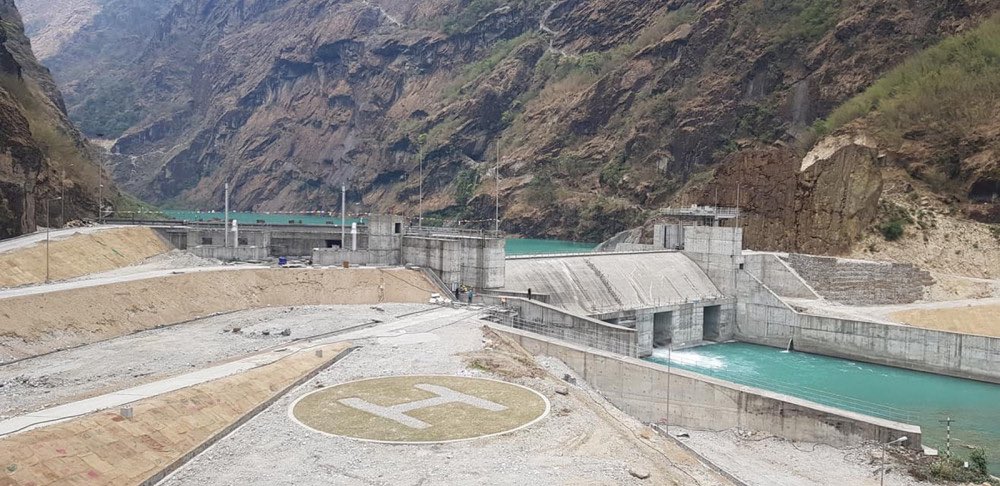Hari Joshi
28 July, KATHMANDU :
Abstract
This study aims at examining the opportunity and challenges of Nepalese commercial banks for renewable energy development. Banking sector is one of the primary sectors and plays very important role in the growth of national economy. Like different areas, banking area additionally has its obligation to secure climate. To satisfy this obligation, the financial area has embraced the idea of Green Banking to find the opportunities and threats of Nepalese commercial bank for renewable energy development. However, this area of research is not explored very well in Nepal. The objective of this study is to identify and explore the opportunity and threats that the Nepalese commercial banks are facing and they are unable to achieve the opportunities and the threats they are facing for financing renewable energies. In order to achieve this objective, data were collected from the secondary as well as from primary sources. These findings will be very helpful for commercial banks.
INTRODUCTION
Financial institutions are important for achieving the basic objectives of countries economic and social progress (Bhandari, 2012) . Since the economic crisis in 2008, the financial institution has adopted principles to ensure that banks business operations not only respond to economic goals but also address their environmental and social issues (Elalfy, 2019). As of mid-July 2019, there are total of 225 banks and non-bank financial institutions in operation including 182 BFIs (NRB licensed 171 and 11 others) 40 insurance companies, Employment provident fund, Citizen Investment Trust and Postal Saving Bank. (Nepal Rastra Bank, 2019). The number of BFIs (including the cooperatives and NGOs performing limited banking operations) licensed by NRB declined to 171 in mid-July 2019. As of mid-July 2019, there were 28 commercial banks, 29 development banks, 23 finance companies, 90 micro-finance development banks (MFDBs) and 1 infrastructure development bank (Nepal Rastra Bank, 2019). Nepalese banking industry has significant changes over past decades as a result of liberalization, deregulation, advances in information technology and globalization (Gajurel, 2010). Commercial Banks, among others are key financial institutions for mobilizing natural resources and keeping the economy alive (Bhandari, 2012) .
Banking system in Nepal was started with the commencement of Nepal Bank Limited (NBL) even before embarkment of Central Bank under Nepal Bank Act of 1994 BS. NBL was a commercial bank which was launched with the joint ownership of government and the public with the equity of 51% by the government (Khadka, 2016). Nepal Rastra Bank (NRB) came simply after nineteen years till date NBL has assumed the function of national bank. The idea of national bank was created by the famous financial analyst Himalaya Samsher JBR. Simply after the foundation of NRB, Nepal’s money related strategy and the monetary guideline strategy enacted in the nation. 10 years after NRB, Rastriya Banijya Bank (RBB), a business bank under the responsibility for administration of Nepal was set up. Also, Agricultural Development Bank (ADB) was built up following two years, the government underlined the open and changed strategies just as the part of the private division for the interest in monetary segments and with the reception of the money related segments advancement in 80’s, Nepal Arab Bank Limited (NABIL) the principal joint endeavor bank and the third business bank of Nepal begun activity in July 1984. Till 2019, Nepal has 27 commercial banks in operation. In the beginning the commercial banks of Nepal started their business in traditional ways. In those days, commercial banks functioned taking deposits and withdraws, the money from the bank through cheque at the cash counter or requesting the bank manager to transfer money from one account to another account (Khadka, 2016).
The name of commercial bank in operation are as: Nepal Bank Limited, Rastriya Banijya Bank,
Kumari Bank, Nabil Bank, Nepal Investment Bank, Agriculture Development Bank, Standard Chartered Bank Nepal, Himalayan Bank, Nepal SBI Bank, Nepal Bangladesh Bank, Bank of Kathmandu Limited, Nepal Credit and Commercial Bank, Prabhu Bank, Laxmi Bank, Global IME, Bank Limited, Citizen Bank International Limited, Prime Commercial Bank, Sunrise Bank, NMB Bank Nepal, NIC Asia Bank, Siddhartha Bank, Machhapuchchhre Bank, Mega Bank Nepal Limited, Civil Bank Limited, Everest Bank, Century Bank Limited, Sanima Bank
The world’s economic growth rate has been declining because of shrinking economic activities in advanced economics, especially in United States, as well as the emerging and developing economics (Nepal Rastra Bank, 2019). According to the World Economic Outlook published by the International Monetary Fund (IMF) in October 2019, world’s economic growth rate is projected at 3.0 percent in 2019 compared to 3.6 in 2018 and 3.8 percent in 2017. Similarly, world’s economic growth rate is projected at 3.4 percent in 2020.
According to David Korslund, senior advisor to the Global Alliance for Banking on Values (GABV) in the conversation with Carol Adams “Sustainable banking start by determining basic human needs to be met and then deliver financial services which meet those needs” and he suggests “most banks start by asking ‘how can we make as much money as possible?’”. Worldwide practical advancement in firmly connected with account. Substantial budgetary speculations will be needed to alleviate and embrace to environmental change, battle craving and react to dry seasons to expand openings for work and backing jobs, and to offer moderate medical services to everybody. Subsequently banks and other money related establishments can assume a significant part in financing practical turn of events and addressing social needs.
Renewable energy has become an integral part of national energy policy goals across many counties post 1973 oil-shock even though the foundations on the economics of exhaustible resources was laid by Hotelling in 1931(see Hotelling,1931). Often perceived as a ‘backstop technology’ (Dasgupta and Heal, 1973; Heal, 2010), renewable energy source is increasingly gaining share in the national energy fuel mix across both developed and less developed economics (Nepal, 2012). Sustainable energy development typically involves three major technological changes: energy saving on the demand side, efficiency improvements in the energy production, and replacement of fossil fuels by various source of renewable energy (Lund, 2007). Nepal is rich in natural resources, which can be utilized for renewable energy production, especially in the form of electricity from hydro, solar and wind power (Islar, 2017) .
However, due to political, technical and economic challenges the majority of Nepalese people still rely on traditional energy sources such as biomass (fuelwood, dung cake, rice husk) as they lack access to the infrastructure needed for modern energy forms (Islar, 2017). According to Surendra K. Ca (2011) When it comes from to fuel type, biomass fuel from wood constitutes the largest share of the consumed energy (76%), followed by petroleum products (8%), animal waste (6%) and agricultural residues (4%). There are three board type of energy sources exist in Nepal: commercial, traditional and alternative energy (Nepal, 2012). Commercial source of energy includes conventional fossil based, carbon intensive (coal and petroleum fuels) and electricity from large hydro plants that leave no footprint to the environment (Nepal, 2012). Traditional energy sources include biomass agricultural by-products and animal waste use for direct combustion (Nepal, 2012). Alternative energy sources include all non-conventional forms of energy such as photovoltaic, micro hydro, wind, biofuels, geothermal, etc. (Nepal, 2012)
Hydropower
Hydropower is clean renewable energy source. Considering the financial, specialized and natural advantage of hydropower, most nations offer need to its turn of events. For instance, China has the most extravagant hydro assets on earth with an absolute hypothetical hydropower capacity of 694GW (Mohtasham, 2015). Creating hydropower is critical to lighten the energy and ecological contamination coming about because of the quick financial development of China and different nations in the 21st century. In the context of Nepal, Water resources are estimated 225 billion m3/km2/year which is 4 times higher than the world average. Hydropower is often promoted as most viable option for Nepal and its future economic developments. However besides of this huge potential, Nepal is currently utilizing 2% of this resource. There are 88 hydropower plants in operation in Nepal with the total generating capacity of 967.85MW; 60 of those plants belongs to the Independent Power Products (IPP) and they contribute 441MW. There are another 113 hydropower plants in the construction stage with total generating capacity of 3090MW (Ramhari Poudyal, 2019).
Solar Power
Solar Power is most abundant source in our planet. In spite of this abundance, only 0.04% of the basic power used by humans comes directly from solar sources because using a photovoltaic (PV) panel costs more than burning fossil fuels (Mohtasham, 2015). The combined PV sun-based age internationally has developed from 3GW in 2003 to 2019GW in 2015, and arrived at 430GW in 2018. Utilizing the PV modules with 12% efficiency, and expecting the daylight of 4.5 hours every day as the public normal, the complete energy delivered by these PV modules is 0.12*4.5*1,47,181*106=80,000GWH/day=17.7TW. If only 0.25% of Nepal was covered with the solar panels having 20% efficiency, enough electricity would be generated to satisfy all of Nepal’s demands. The expense of new photovoltaic force is dropping quickly, and if the photovoltaic business keeps on developing and improve mechanically, by 2020 the cost will be practically identical to the expense of customary force, as will the expense of sun oriented warm force.
Wind Power
Wind power is one of the most widely used renewable energy resources in the world. Nepal’s tall and breezy mountains are entirely reasonable for sending wind turbines. Wind turbines rush to introduce, and they take substantially less space than sunlight-based clusters. For example, a 100MW breeze ranch can be raised inside a half year. Bigger breeze turbines yield less expensive expense of power age, yet the essential concern is the street access for their establishment. A breeze turbine changes over the motor energy(movement) of wind into mechanical energy that is utilized to produce power. The energy is taken care of through a generator, changed over a second time into electrical energy, and afterward took care of into the lattice to be send to a force station. Like other renewable energy sources, wind energy has many advantages. It reduces greenhouse gas emissions by using turbines, which produce energy and electricity when moved by the wind, and can reduce electric cost. All the turbines need to order to function in wind, which is just air in natural motion, and air is everywhere. The utilization of wind energy is growing faster than solar PV generation with the annual increase in capacity of around 20% growing from 39GW in 2003 to 318GW in 2013 and reaching 600GW in 2018 (Ramhari Poudyal P. L., 2016).
Biomass
Since Nepal is mostly agricultural country, livestock and farming activities produce massive amount of biomass. However, the conventional utilization of biomass makes the indoor air contamination. Concurring the World Health Organization, more than 4 million individuals every year bite the dust worldwide because of ailments brought about by the family unit air contamination from cooking with the strong fills, for example wood, harvests and creature fertilizer. In 2014 a conservative forecast by the Winrock International predicted that the remaining technical potential of biogas is about 0.9-1.3 million plants. Despite the fact that there is no gauge the number of these plants can turn out to be enormous business frameworks, at present there are 365,000 family biogas frameworks, 10 network frameworks and 370 institutional bigger biogas frameworks in the activity overall as indicated by the World Bank.
EXPERIMENTAL SECTION
It is worth mentioning that financial institutions play an important in leasing sustainable development. Weber (2014b) analyzes this relationship in four aspects. First, the financial sector has control over access to funds, which has a direct impact through investment in certain sectors on an indirect one through their landing activities (Weber, 2019). Second, stakeholders of financial institutions can influence, through their pressures, the reputational risks of financial institutions (Weber, 2019). Third with the advent of consequences of global warming, for example, floods and hurricanes in many areas in North America financial institutions have started to respond to sustainability risks by incorporating shadow prices (Weber, 2019). Fourth the financial sector has a real challenge to technically test the relationship between finance and the impact on the economy, society and the environment (Weber, 2019). Renewable technology offers suitable opportunity to electrify rural areas as the technology is capable of making better use of locally available resources, such as sunlight, biomass, wind and hydropower (C.Hope, 2000).
According to the Nepal and Jamasb (2011) to the civil war between the Maoist rebellion and the government of Nepal meant that political instability severely affected the state-owned sector including the energy sector, leading to fragmented leadership, changing priorities and policy discontinuity. Currently Nepal faces structural challenges in its electricity sector such as a burden of price subsidies, low service quality, low bill collection rates and high losses due to poor network and service coverage experienced under state owned and controlled systems (Jamasb, Jan,2012).
Some points are listed as to show the problems that the bank and financial institutions are facing to invest in renewable energy development:
- Due to the high investment to develop renewable energy and the capacity to invest for commercial banks is low so they are unable to handle big projects.
- No loan guarantee by government to invest in renewable Energies for Nepalese commercial banks.
- Providing the strategic regulatory change needed to support renewable expansion.
- In many developing countries like Nepal long term financing is difficult and sometime impossible to get this is due to regulatory or other restriction on long term bank lending.
- While enormous quantities of renewable energy technologies project developers exist, there are only limited numbers of large-scale project sponsors, especially in the least develop countries like Nepal.
Nepalese commercial banks are the major determinants for achieving common objectives of national economic goals and helps for developing the life standard of Nepalese citizens. Despite of having sufficient opportunities some points are lagging for utilizing renewable energy in Nepalese commercial banks they are as follows:
Low Availability of energy
“Outside the major cities, life in rural Nepal comes to a halt every time sun goes down” (Rana, 2012). The accessibility of energy assets involves giving continuous and satisfactory flexibly with the lower level of reliance on imported products of non-renewable energy source. In these unique circumstances, the accessibility of fuel sources in Nepal is at a basic stage. Although developing, Nepal’s energy supply cannot meet the demand of the population.
High dependency level
Arranged in the middle of two monster petroleum product economics, China and India, the geo-political situation of the Nepal makes difficulties for guaranteeing a steady, independent and decentralized energy framework. As a landlocked country, Nepal is heavily dependent on both India(61% of all imports) and China( 15% of all imports) for overland suppliers ranging from medicine to petroleum products (OEC, 2015) and nearly all fossil fuels imported to Nepal are imported and refined in India (Surendra K.Ca, 2011).
Unstable government Policy
In general business disdains strategy hazard, which is seen as one of the most unusual and along these lines’ unquantifiable types of danger. If approaches are effective will be controlled by whether they impact speculator choices. Government therefore needs to focus on balancing its own need for decision-making flexibility with businesses need for certainty.
RESULTS
Expanding the renewable energy share in national energy mix remains one of the major energy policy goals across many economics. The review of literature reveals that various scholars at national as well international level have initiated different studies on different aspects of opportunities they are achieving and the challenges they are facing by the commercial banks of Nepal. But at the national level there are very few researches and been long time there is no research on what exactly the opportunity and challenges faced by commercial banks of Nepal so, my present study will be an attempt to fill this gap and make a recommendation for the achievement of desired goal. Some other gaps are as follows,
- Investing in renewable energies by bank and financial institution helps the nation for overall development of economics from different angles such as: create huge number of job opportunities, Maximum utilization of available resources, development of physical infrastructure and so on which part is missing and ignored by Nepalese government and commercial banks.
- Recommendation and possible solutions are not clearly mentioned.
- There is contradiction between individual investor and financial institutions for investing in the hydropower sector of Nepal. Nepal government imposes the rule for the development of Nepalese hydropower sector is no any sources needed for Nepali citizen holders to invest in Nepalese hydropower but Nepal Rastra Bank imposes that there must be verified income source to invest in hydropower which helps to demotivate for investors and this part is really ignored in previous studies.
- The lengthy credit policy imposes by Nepalese commercial Banks to invest in renewable energy such as hydropower, solar, Biomass which discourage for the development of renewable energy which is not clearly mentioned in research.
- The renewable energy business still viewed by the bank as a development area but the focus is on opportunities in ‘more secure and well-known market’ just as existing customers and more develop subsectors, for example wind, solar and waste. While it is getting harder for these advancements to get financing from Nepalese bank and financial institutions.
- Government of Nepal is focusing on to decrease the poverty level of Nepal by increasing the government plans to increase the bank loan in marginal and deprived sector but Nepalese commercial bank is focusing to invest in productive sector but Government of Nepal is not assuring for loan guarantees for investing in renewable energies.
- Nepal government imposes the rule for the development of Nepalese hydropower sector is no any sources needed for Nepali citizen holders to invest in Nepalese hydropower but Nepal Rastra Bank imposes that there must be verified income source to invest in hydropower which create confusion between
- Most of the commercial Banks are providing Debit as well as credit card related products to their customers and those products are operated by ATM (Automatic Teller Machine) and POS (Point Of Sale) Machine which really needs an energy for operation but if something went wrong in electricity then there is just UPS (Uninterruptible Power Source) which has not enough power backup and at that moment renewable energy plays a vital role which is ignored by commercial banks of Nepal.
- Nepalese government is providing the subsidy in solar energy for the Nepalese citizens which lives in rural areas but most of the rural areas people are very unknown about this subsidy and compel to use nonrenewable energies this part is not been researched.
- The budget presented by Nepalese government in 2020 for increment in tax in electric vehicle which demotivates the renewable energy users is not researched yet.
CONCLUSIONS
Analyzing the present energy situation in the context of Nepal which seems that the demand of renewable energy is high comparing to its supply. It is important to understood how the energy demands are going to advance in the years to come. The main objective of this research is to look at the circumstances of investment in renewable energies by the commercial banks of Nepal by analyzing the opportunities they are gaining and the challenges they are facing for available renewable energies in Nepal. Some points are highlighted as:
- By analyzing the energy consumption pattern by sectors and by sources from 2010 to 2020 the use of renewable energy is on increasing trend but Nepalese commercial banks are not very interested to invest in these sources because of many controversy issues.
- Due to current problems that the commercial banks are facing to invest in renewable energies only the minimum sources are utilized.
- There are many hidden opportunities that are ignored by bank and financial institution for investment in renewable energies.
- Due to slow decision-making process by Bank and financial institutions block to move in allowing anticipatory investment in renewable energies.
- There is Contradiction in Nepalese government and Nepal Rastra bank for investor to show the income sources to invest in hydropower.








